How to prune ficus?
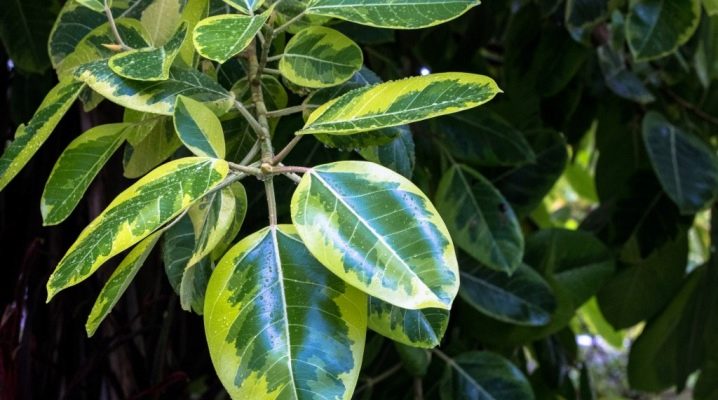
When creating a cozy atmosphere in a house or apartment, plants are indispensable. Evergreen flowers with abundant greenery look especially beautiful. A more exotic option is miniature shrubs and trees. A common representative of this type is ficus. This plant is great for decorating not only living quarters, but also offices. In addition to the decorative function, it also performs wellness. Like most indoor plants, ficus enriches the room with oxygen. This plant is quite unpretentious and, with proper care, will be able to delight its owners for more than one year. In addition to watering and loosening the soil in a pot, the ficus needs to be pruned, since it can reach 10 meters in height. Therefore, to get a miniature and healthy plant on the windowsill, you need to prune in a timely manner.

Trim time and tool preparation
When choosing when to prune branches, you need to understand its purpose. This could be:
- removal of dead leaves or branches;
- the formation of a fluffy crown.
In the first case, trimming is performed immediately. You should not wait for a suitable time, since delay threatens with sluggish growth of the plant and the appearance of withered foliage. The reason for this is the excessive consumption of nutrients in an attempt to maintain dying elements.
In the second case, the branches are pruned during the active growth of the plant, which begins in early spring and ends in mid-summer. For domestic ficuses, this is the period from March to June.
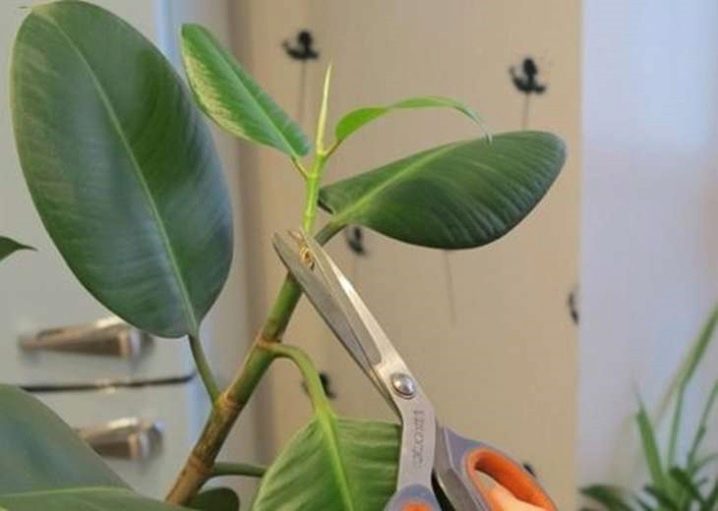
If the plant was recently transplanted, then it is better to give it some time to adapt and only then prune it.
Also, do not engage in the formation of the crown of the ficus during the period of autumn-winter dormancy. If you neglect this rule, then the plant can become skewed. The reason for the curvature lies in the fact that in winter shoots are formed only in the places of the cut. In addition, crown formation during dormancy can weaken the plant, from which young shoots will take useful substances for growth.
Before performing this procedure, you must take care of the tools. For this you will need:
- garden shears (large and small);
- secateurs (knife);
- disinfectants (alcohol and garden var).
Alcohol is used to disinfect the instruments, and soda water is used to cover the fresh cut. It must be remembered that only sharpened tools that are capable of making a clear cut can be used to perform the procedure. If this rule is not followed, the branches at the cut points may crack or delaminate. Bacteria are often trapped in such cracks.

How to prune ficus correctly?
There are two main types of pruning: sanitary and anti-aging. Each of them has its own characteristics that must be taken into account when performing this important procedure.
Sanitary pruning
Proper care of the ficus plant includes periodic inspection of the plant for damaged or dying branches. Such formations are very harmful to the ficus, since through them the disease can pass to the healthy part of the crown. Therefore, pruning should be done immediately after detecting a problem.
Weakened and old branches, which can become home to various pests, must be removed. I like these parts of the ficus and all kinds of viruses. Therefore, they need to be cut without regret.You need to shorten the branches to the point where the dried area ends. You can even grab the healthy part of the plant a little to get rid of the problem completely. In the event that the shoot reaches up straight from the ground, it can be shortened to the very soil.
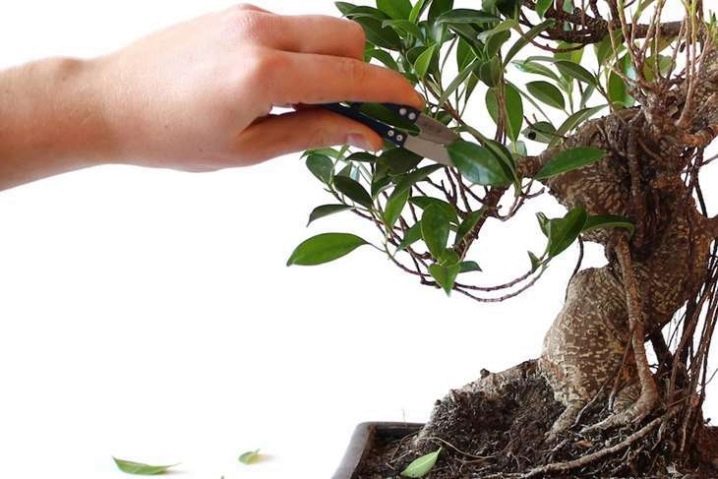
Rejuvenating
Rejuvenating pruning is necessary when the top of the plant has been damaged by the cold or has begun to dry out due to disease.
Dwarf ficuses, which are most often grown at home, can be cut off completely. They tolerate this pruning relatively easily.
This procedure involves the complete removal of the crown, after which a bare trunk remains., which will contribute to the emergence of new shoots from the roots.
If, on a plant with long shoots, the leaves begin to dry out due to the heat, then it is necessary to trim all the branches on it almost completely. On each of them, 2 buds are left, necessary for the formation of new cuttings, from which in the future it will be possible to form a new crown. But in the process of formation, you must also follow certain rules.
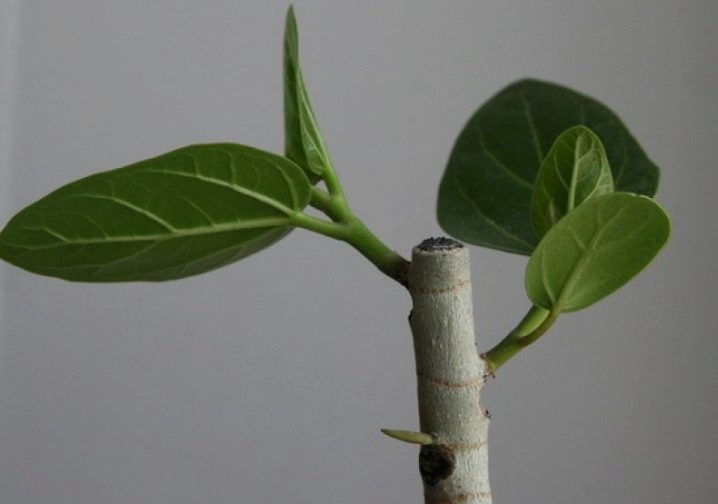
Crown formation
This process requires a creative approach. Before getting to work, you need to carefully consider the shape of the top of the plant, as well as its desired height. To create the right outlines, it is better to take into account all the nuances of the upcoming process.
It is necessary to start pruning from the place that is located above the apical bud. Do not cut too high, as this part will protrude above the leaves of the new shoot, which does not look very aesthetically pleasing. It should be remembered that the rules for pruning old branches and young ones are different. In the first case, the cut is made at an angle of 45 degrees, and in the second, at an angle of 90 degrees.
It will also be useful to thin out internal shoots if there are a lot of them. This will help the crown become more lush. Particular attention should be paid to the position of the upper kidney during the procedure. To obtain a fluffy crown, it must be directed outward. If the upper part of the plant lacks volume in width, then the bud should have a horizontal direction. In the case when upward growth is preferred, the kidney is directed vertically.
To create a more interesting look, you can choose a special decorative shape for the crown. For example, tiered. The plant also looks great in the form of any geometric shape. This design will add zest to the interior of the room. An unusual and stylish option will be one of the forms in the bonsai style. It is not necessary to copy small sizes.
The decision to cut the ficus in the shape of a trunk is also original. At first glance, such a task seems difficult, but it is quite simple to do it. First you need to determine the desired plant height, and then pinch the topmost bud. After that, the lower branches are cut off, which do not fit into the intended dimensions or geometry of the figure. And at the end, align the shape on the sides.
When using this design on a tall plant, several tiers can be made, rather than one. But this option is only suitable for young trees.

The crown bush is another common form of ficus. A lush bush in a flowerpot always looks beautiful and modern. In order to give it a shape, it is necessary to pinch first of all the upper bud, after which the branches will begin to grow not upward, but in breadth. The foliage will also increase. When the length of the side shoots reaches 10 cm, they must also be cut off. In the future, the branches must be periodically cut to maintain their shape.
From small-leaved varieties, you can create not just a certain shape, but a real sculpture. It can be a bird or an animal. To do this, you first need to achieve the most lush crown possible by cutting off excess shoots. First of all, this applies to branches growing inward. You only need to leave shoots directed to the sides and up.This will cause the crown to branch out, which will make it easier to create the desired outline. For complex shapes, you will need a wire frame. Experienced gardeners use this method when they want to add uniqueness to the interior of the room.
In the process of decorative pruning, it is important to remember the age of the plant. Pruning does not harm a young ficus, and you need to be careful with older plants. In perennial ficuses, the branches are less flexible, so any manipulation with them can lead to injury to the plant.
If there are several ficuses available, then unusual and interesting compositions can be made from their crowns and trunks. The most common option is to transplant them into one large flowerpot and then trim the crown of the two plants as a whole. In this case, the trunks can be curled in the form of a pigtail, for which all the lower branches are also cut off.
The splendor of the crown of the ficus can be increased by periodically pruning the upper shoots. In this case, lateral buds begin to activate on the plant. To obtain the maximum effect, the procedure is carried out during the active period (spring and summer).
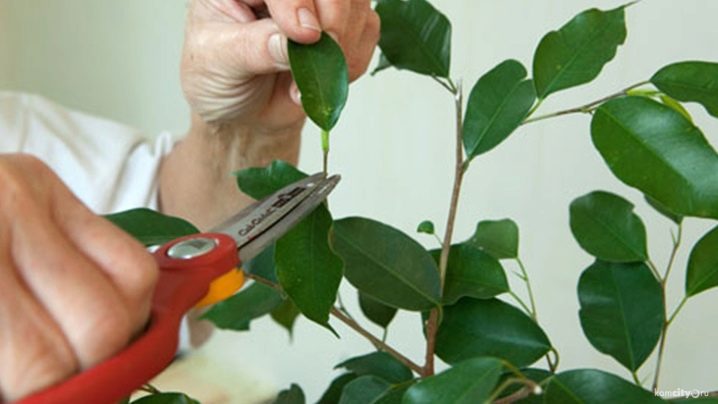
You can also further stimulate the growth of shoots in the right place. To do this, a needle makes holes in the main barrel with a size corresponding to 1/3 of the barrel diameter. It is necessary to make at least 3 holes, but the escape should be expected only from the lower one. Therefore, you need to start from the very top of the plant. It should be noted that when transplanting a young plant, roots are also formed. So, the longest of them are removed, like most of the crown of the ficus tree. To maintain its shape, the crown must be pruned periodically (once every 2 months).
However, you should be aware that unusual decor in the upper part of the tree can be formed without pruning. This is done by changing the direction of growth and fixing the shoots in the required position for a while. The fixing devices can be different. The only criterion is their softness. Retainers should not violate the integrity of the ficus bark. With the right approach, this method is the least traumatic for the plant.
Care after the procedure
After pruning, the ficus begins a period during which it must adapt to the changes received. It is necessary to create certain conditions for the flower to grow and bush faster:
- do not allow the soil to dry out in the pot;
- water with a small amount of water, but constantly;
- after 3-4 weeks, you need to feed the ficus;
- do not transplant earlier than 2 weeks after pruning.
When the care process is carried out in compliance with all of the above rules, the plant looks beautiful and lush.
In appearance, you may not even guess that something was done with the ficus. In fact, he is quite weak and can easily get sick if handled incorrectly. To normalize his condition, it is necessary:
- do not spray the leaves for a while;
- do not leave the plant in the cold (when the temperature is below room temperature);
- do not allow excess moisture in the pot;
- carry out periodic fertilization of the soil.
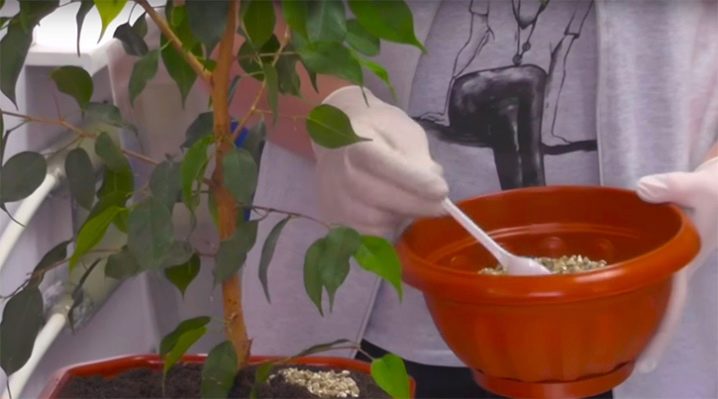
You also need to remember that immediately after completing the procedure, it is better to place the plant in a dark place. This will make it easier for Ficus to adapt. Do not put ficus in a weakened state tightly to other flowers. This can cause the appearance of various pests.
If, nevertheless, the disease could not be avoided, then the ficus should be treated as quickly as possible. The most common parasite living on this plant is the spider mite. He, like most other dangerous insects, appears with a large grouping of flowerpots with flowers and violation of sanitary standards.
The appearance of a tick is noticeable not only by the white spider web, but also by small brown or gray specks on the foliage. This insect is very fond of dry air and warmth. Therefore, for treatment, it is necessary to promptly increase the humidity by spraying the leaves of the ficus several times a day.It also does not hurt to wipe them with regular soapy water. And when simple methods do not help, you can treat the ficus with an insecticide.
For maximum effect, the plant can be wrapped in a plastic bag for a while.
But it is better to prevent diseases by taking proper care than to treat them for a long time. Then the lush crown of the ficus tree will delight the owners and guests of the house for a long time.
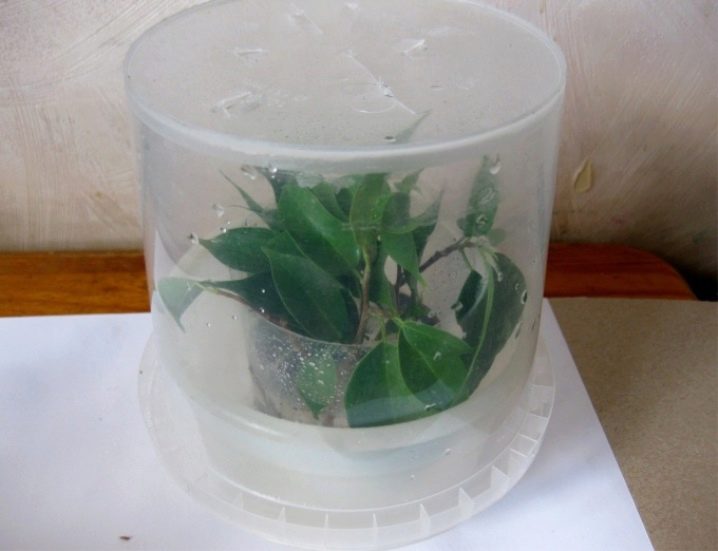































The comment was sent successfully.